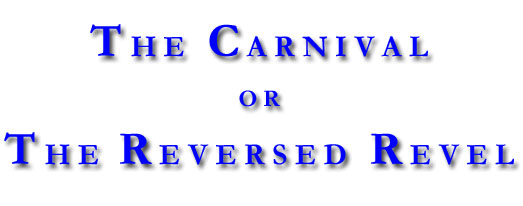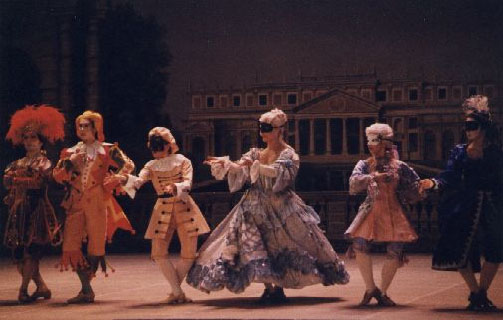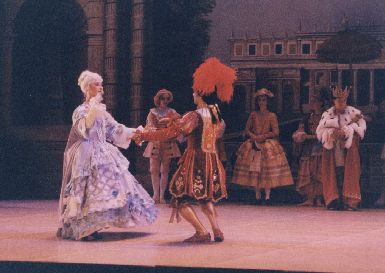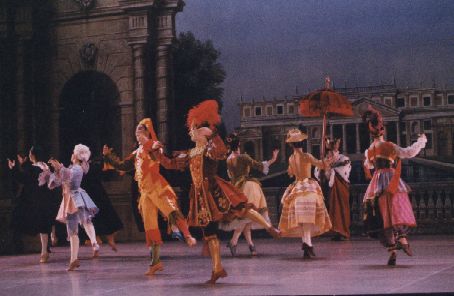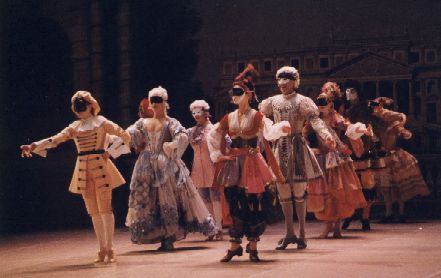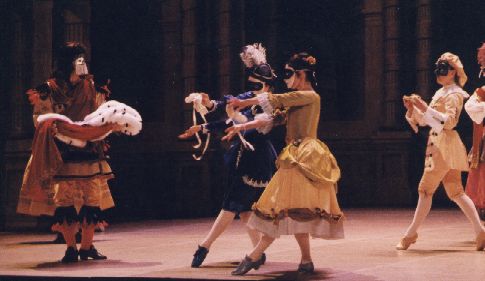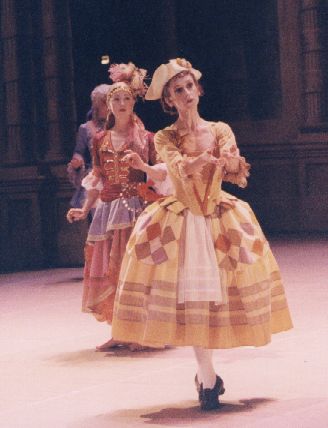
Home Page
L'Eventail
Exhibition Parcours Baroque
NEW
Le Ballet de l’Amour Malade
Saynètes des rues, des rivières et des bois
Prologue au Cabinet des Fées
Don Juan
Voyage en Europe
The Carnival
Les Caprices de la Danse
Ballet des Masques
Press Review
Links in Baroque Dance
L’EVENTAIL BAROQUE DANCE COMPANY
and
LE CONCERT SPIRITUEL
present
Ballet-Comédie
Music by Joseph Bodin de Boismortier (1689-1755)
The four Village Ballets, opus 52
The First Serenade or Simphonie Françoise, opus 39
An original creation by L’Eventail Baroque Dance Company
and Le Concert Spirituel instrumental ensemble
Coproduced by the Région Lorraine, the Arsenal de Metz,
the Festival de Sablé-sur-Sarthe
the Adami and the Spedidam
in residence at Espace Carpeaux in Courbevoie.
| Design | Marie-Geneviève Massé and Hervé Niquet |
| Choreography | Marie-Geneviève Massé |
| Musical Direction | Hervé Niquet |
| Costumes | Alexandre Vassiliev |
| Set | Nicolas de Lajarte |
| Text | Jean-Yves Patte |
| The 12 dancers of L’Eventail Baroque Dance Company
One actor The 18 musicians are from the Concert Spirituel |
|
| Length of production | 1 hour 30 mins |
The creation of this production returns to the source of our past where carnival and dance were omnipresent. By exploring the history of Carnival through dance, our aim is not to recreate it to bring out old ghosts, but somehow to rediscover traces of some hereditary genes!
The atmosphere of collective feast of the carnival becomes a way of revealing dance as the most intimate expression of mankind; a mankind with multiple reflections going far beyond artifice and appearances installed by the baroque period.
[Back to top of page.]
Le Carnaval ou la Fête à l’envers
In the town, the party is in full swing. A joyous company on the arms of the Captain of Youth is looking for a King Carnival.
Colin, the young dandy from Pontoise, as vain as a peacock, and Collinette wander around, their minds full of wild dreams. A bear appears, two Egyptian women, the Jester, the Prince of Vanities…
They convince him to become the King Carnival. Once in this court organised for the Pleasure and Folly, entertainments, burlesque dances and death follow one another, according to the dazzling meetings with Coquillard, the doctors in the Moliere’s manner, the Captain of Youth, the Pantomime horse…
Melodic and popular, Boismortier’s music plunges us into this Carnival with humor and simplicity.
Composition of the brotherhood of
King Carnival’s dancers
Colin 1st, King Carnival
Christophe Sigognault, comedian
The Prince of Vanities, the registrar Coquillard,
The Old Treasurer or the Bride, Lady Lent
Bernard Delattre, comedian-dancer
Colinette, Colin’s friend
The Princess of Vanities
The Captain of Youth or the Prince of Good Time
Scapin, the Prince’s servant as the Carnival Jester
The Pantomime Horse
The Marquis, Fanfan de Sotteville
Turlupin, the Marquis’ servant
The Suitor
The Groom
Colombine
Two Egyptian Women
Three Doctors
The Bear
A Shepherdess
Two Lucies
Two faced Janus
The Devil
[back to top of page.]
The course of the production
Lead by the Prince of Good Time or the Captain of Youth and the Carnival Jester, the actors double up according to the number of sketches that the revel requires.
The Serenade will be the support to the dramatic outline: as a narration, it makes the action progress, the village ballets will be arias: stolen moments during the action. They will be moments of entertainment within the play.
The Serenade is made up of 18 pieces, divided into several sections; it underlines and determines the king’s stroll and its consequences: his election, reign, judgment and sentence then execution which ends of the reversed revel whilst each village ballet looks at one of the traditional carnival themes.
Synopsis of the ballet
Act I
In town, the party is in full swing. One can hear the cries. A joyous company on the arms of the Captain of Youth is looking for a King Carnival.
Colinette, young and fresh, and Colin, the young dandy from Pontoise -as vain as a peacock and made fool by his own vanity- wander around, their minds full of wild dreams. Colin incessantly tells Colinette about his dreams: how to get out of his modest background. Why he who only dreams of grandeur, could he not, in a time when anything is possible, meet Lady Fortune who can change the path of one’s life?
He is suddenly interrupted in his thoughts by a bear. Fortunately two Egyptian women manage to calm down the furious beast. Colin thanks them whilst the two women attentively scrutinize Colin’s fate engraved in the palm of his hand: it is undoubtedly magnificent.
As if by magic, a mysterious lady appears: it’s the Princess of the Vanities. Helped by the Jester, they convince him to become the King Carnival. Colin is overwhelmed with happiness. A whole joyous carnival troop appears lead by the Captain of Youth, Janus and the shepherdess, the Marquis Fanfan de Sotteville and his servant Turlupin... all coming for the coronation.
Act II
In this Court devoted to Pleasure and Folly, the Jester announces an entertainment offered to the King.
It’s a farce, an endless story of lovers, an eternal mistaken identity: will they finally find each other? Are they sick? Let them be cured! The Medicine -Cure-All- reinforced by blood-lettings and enemas will cure them of their blindness.While so pleasant, why not trying to make it last forever? Colin decrees laws, an inflexible code: the Code of Good Living. But with Coquillard, the faithful deformed and fool registrar, things are not that easy.
A new colorful scene is performed for the Carnival’s Court. The old Faded Beauty of a Treasurer, wanting her charms to last forever, is to marry Fanfan de Sotteville, a naive one even more naive than naivety itself... Then a strange reversed marriage takes place.
The King orders a dazzling party and an entertainment to be offered to the newly weds. It’s the ballet of metamorphosis led by the Egyptians’ bear. But suddenly, oh heavens, he transforms himself into the devil...
Act III
What a big mess! The Jester looks for the King and the Devil comes back with the worrying Lady Lent.
An Imaginary Court is installed to judge the King. The battles rage but Lady Lent takes them away and reinstates the law. After such a parody, the King is convicted. He must give up his reign and even make a burlesque will! Lady Death, the Devil and his fiends hunt him down in a death dance.
The masks fall, the Chaconne sings the farewell cries of separation until the next season.
Only the Jester remains: he is wearing the coat of arms, the ridiculous remains of a dazzling party.
But when he turns the arms over, we discover the Carnival’s effigy in the middle of the flames.
It is really the end of the dream, of a... reversed revel.
[Back to top of page.]
The characters of the ballet
In the 18th Century, 3 distinct factors determined the kinds of dancer’s roles. Master Noverre defined them as:
- noble, tragic or heroic genre, a serious and majestic dance,
- half-character of pastoral genre, a half-serious dance for a voluptuous, tender and galant dance,
- character, burlesque or popular genre, a grotesque dance meant to be rustic, naive and comic.
All of our characters would naturally take to one of these or another genre according to their character but also reverse themselves as the carnival is a period of inversion.
But it’s not only a question of opportunity or impunity behind the mask: the revel must appear as an ungraspable mystery. No mask totally conceals its wearer, on the contrary, it reveals him. It’s not only the face which is false but also the body remade with the way the head is hold, it’s walk, dance and movements.
Carnival in the French 18th century
The Carnival is a short period of revels and masked balls, of games and pleasures before the penitence and restrictions of Lent.
It unites custom and institutions, tradition and history. In the 18th century, the Brotherhoods of Carnival -modern equivalent of “groups”, “bands” and “troops”- proved that the main expression of carnival was youth and folly. It’s a time of derision, with the inverted election of an imaginary king to whom is granted freedom of command and speech: during the time of the carnival, his power is short-lived. The ritual of the King Carnival remained a permanent and unanimous framework which always insisted on the well-ordered expression of “La Folie”: his solemn entrance, his presence under a canopy, the final judgment and his disappearance in the flames.
On the other hand as attests a young clerk in 1665, it is a very organized kingdom:
« Musique de cour pour un roi de carnaval » L’Est Républicain, May 12, 1999.
« Baroque : pour le plaisir des yeux et des oreilles » Le Républicain Lorrain, May 21, 1999.
« “ Le Carnaval ou la Fête à l’envers ”, rafraîchissant mélange de danse et de musique baroques »
Renaud Machard, Le Monde, June 4, 1999.
« Le Carnaval de Marie-Geneviève Massé » Figaroscope, May 26, 1999.
« Carnaval à Versailles » Figaro Madame, May 29, 1999.
Les Saisons de la Danse, Philippe Verrièle, september 1999
[Back to top of page.] [Version française.]
Number of visitors
Copyright © L’Eventail 2004
